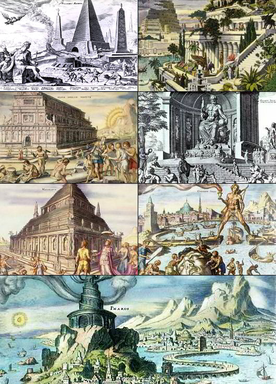Seven Wonders of the Ancient World

The Seven Wonders of the Ancient World (from left to right, top to bottom): Great Pyramid of Giza,Hanging Gardens of Babylon, Temple of Artemis at Ephesus,Statue of Zeus at Olympia, Mausoleum of Halicarnassus,Colossus of Rhodes, and the Lighthouse of Alexandria as depicted by 16th-century Dutch artist Marten Heemskerk.
The Great Pyramid of Giza (called the Pyramid of Khufu and the Pyramid of Cheops) is the oldest and largest of the three pyramids in the Giza Necropolisbordering what is now El Giza, Egypt. It is the oldest of theSeven Wonders of the Ancient World, and the only one to remain largely intact. Egyptologists believe that the pyramid was built as a tomb for fourth dynasty EgyptianPharaoh Khufu (Cheops in Greek) over an approximately 20 year period concluding around 2560 BC. Initially at 146.5 metres (480.6 ft), the Great Pyramid was the tallest man-made structure in the world for over 3,800 years. Originally, the Great Pyramid was covered by casing stones that formed a smooth outer surface; what is seen today is the underlying core structure. Some of the casing stones that once covered the structure can still be seen around the base. There have been varying scientific and alternative theories about the Great Pyramid's construction techniques. Most accepted construction hypotheses are based on the idea that it was built by moving huge stones from a quarry and dragging and lifting them into place.
There are three known chambers inside the Great Pyramid. The lowest chamber is cut into the bedrock upon which the pyramid was built and was unfinished. The so-called[1]Queen's Chamber and King's Chamber are higher up within the pyramid structure. The Great Pyramid of Giza is the only pyramid in Egypt known to contain both ascending and descending passages. The main part of the Giza complex is a setting of buildings that included twomortuary temples in honor of Khufu (one close to the pyramid and one near the Nile), three smaller pyramids for Khufu's wives, an even smaller "satellite" pyramid, a raised causeway connecting the two temples, and small mastabatombs surrounding the pyramid for nobles.

